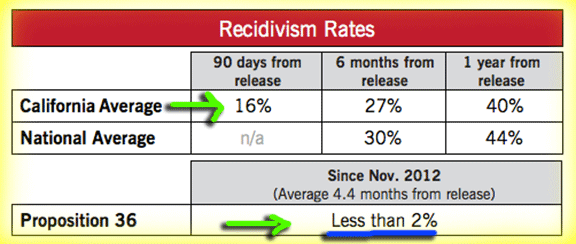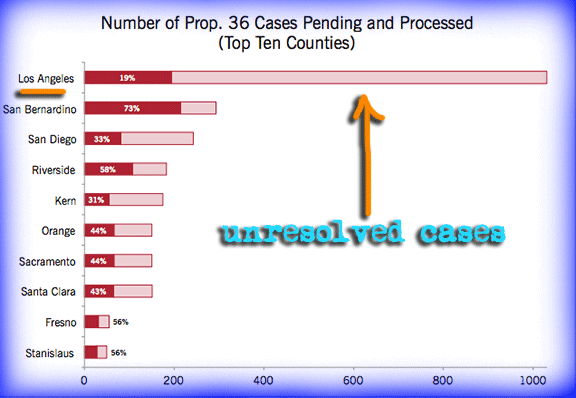LOW RECIDIVISM RATE AMONG THIRD-STRIKERS RELEASED UNDER PROP 36, SAYS REPORT
Since the 2012 passage of Prop 36 (the Three Strikes Reform Act), only 2% of the more than 1000 third-strike inmates released in California have reoffended, compared with the statewide average recidivism rate of 16%.
The LA Times’ Jack Leonard has more on the report. Here’s a clip:
More than 1,000 inmates previously sentenced to life in prison have been freed since voters approved changes to California’s three-strikes law in November, with only a handful charged with new offenses since their release, according to a report released Monday.
The authors of the report, who helped write and campaign for the ballot initiative, said third-strikers released under Proposition 36 have a lower recidivism rate than other prisoners freed on parole, helping save the state millions of dollars by opening up space in crowded prisons without jeopardizing public safety.
But the authors raised alarms about a lack of housing, substance abuse and other types of reentry programs available to third-strikers released from prison. And they expressed concern that L.A. County has been lagging behind other counties in clearing its backlog of cases in which inmates are seeking release under the ballot measure.
More than 2,000 inmates statewide are awaiting court decisions on whether they should be resentenced under the proposition. More than 800 of those have filed requests in L.A. County, the report said.
The report, co-published by the Stanford Three Strikes Project and the NAACP Legal Defense and Eduction fund, also found that more than 800 of the approximately 1000 inmates eligible for release under Prop. 36 in Los Angeles are still waiting for their cases to be processed—a much higher percentage than other California counties.
MAJOR DROP IN JUVENILE COMMITMENT NUMBERS ACROSS THE NATION
According to a new Pew report, the national youth commitment rate—juvenile court-ordered lockup—has dropped 48% from 1997 to 2011. California had the 10th largest reduction at 63%. (Go here for the infographic.)
James Swift of the Juvenile Justice Information Exchange has more on the report which features an analysis of the multiple causes for the decline. Here’s a clip:
Nationally, the Pew Charitable Trusts say that the juvenile commitment rate has nearly decreased by half since the late 1990s, with estimated U.S. figures dropping by 48 percent from 1997 until 2011.
The report, which used statistics from the Office of Juvenile Justice and Delinquency Prevention’s Census of Juveniles in Residential Placement database, shows a marked drop in juvenile commitments between the 2006 and 2011 period. At 34 percent, the overall decrease in juvenile commitment rates was almost twice as high as the reduction rate recorded from 2001 to 2006.
“There are at least three factors contributing to the decline,” said Adam Gelb, Public Safety Performance Project director. “Some contribute it to a declining juvenile population, and some to a drop in juvenile arrests but the main factor seems to be a shift in how the court system is responding to juveniles who are arrested.”
LA COUNTY SUPES KNABE AND RIDLEY-THOMAS CALL FOR SUPPORT OF CALIFORNIA LEADERS’ PRISON PROP REDUCTION COMPROMISE
LA County Supervisors Don Knabe and Mark Ridley-Thomas Tuesday proposed that the board direct their lawyers to file a friend of the court brief in support of the deal reached by Gov. Jerry Brown and state legislative leaders to request more time to reduce California’s prison population.
If you missed it, state leaders Monday agreed to submit to the federal three-judge panel Senate President pro tem Darrell Steinberg’s request for an additional three years to implement rehabilitative strategies. If the judges don’t agree to the proposal, Gov. Brown would satisfy the court order by the December deadline with a $315M private prison deal. (For more backstory go here and here.)
The supervisors are expected to vote on the issue at next Tuesday’s board meeting. (We urge the board members to approve Knabe and Ridley-Thomas’ proposal, as Brown’s costly alternative would have long-term harmful consequences for the state.)
Manhattan Beach Patch posted this story from the City News Service. Here’s a clip:
Los Angeles County Supervisors Mark Ridley-Thomas and Don Knabe Tuesday urged their colleagues to support a compromise reached in Sacramento to reduce the state’s prison population. Under federal court order to cut the number of inmates in crowded state prisons, Gov. Jerry Brown and state lawmakers on Monday agreed to spend $315 million on substance abuse, mental health and rehabilitation programs — rather than paying for cell space in private prisons — if federal judges agree to extend an end-of-year deadline to release more than 9,600 prisoners.
Ridley-Thomas and Knabe proposed that county lawyers file a friend of the court brief in support of the state deal.
“This compromise is to be applauded,” Ridley-Thomas said. “From a policy perspective, we simply cannot continue to over-utilize incarceration as our sole public safety solution. It’s not practical, it’s not economical and it’s not moral. Reducing our prison population and halting recidivism will require us to adopt strategies for rehabilitation as well.”
HOMEBOY INDUSTRIES 5K RUN/WALK NEXT SATURDAY
Saturday, Sept. 21, join Father Greg at the Los Angeles State Historic Park for the 2013 Homeboy Industries 5K. The event starts at 8:00a.m. (registration for runners is at 6:00a.m.). If you don’t want to run, you can also volunteer, sponsor runners, or donate to Homeboy.
Here’s what proceeds from the 5K go to:
Homeboy provides hope, training and support to formerly gang-involved and recently incarcerated men and women, allowing them to redirect their lives and become contributing members of our community. Proceeds from 2013 5K Run Walk donations will help Homeboy provide an extensive training program that empowers men and women to undertake what is often their first “real job.”
Find out more about the event and sign up here.



Come on C! The study was only for guys that had been out FOUR months!!I read the study what a sham! Add, done by the NAACP and Stanford who has a bias to support a preconceived findings. Wasn’t worth the read!!! We must try again at something else! Once again NOTHING about help for the victims in the study!!
The study on recidivism rates counts those arrested/sent back on a violation. It doesnt mean the 3 strikers werent out capering….just that they werent caught. Perhaps after three prison stints they got a little smarter or at least a little more discreet. By the time someone has gone to prison three times they arent likely to change. Change would have occurred after the first stint. They are out capering and just havent been caught